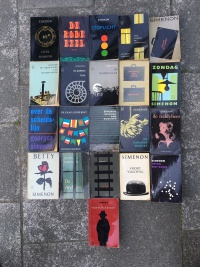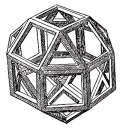Georges Simenon
From The Art and Popular Culture Encyclopedia
|
"Comprendre et ne pas juger"--Georges Simenon "I consider myself an impressionist, because I work by little touches. I believe a ray of sun on a nose is as important as a deep thought."--Georges Simenon, spurious "He eschews all rhetorical effect – there is rarely more than one simile per book, and no metaphors, let alone anything approaching a symbol. There is text, but no subtext; there is plot but no subplot." --Julian Barnes, 2014 "Kitsch's enormous profits are a source of temptation to the avant-garde itself, and its members have not always resisted this temptation. Ambitious writers and artists will modify their work under the pressure of kitsch, if they do not succumb to it entirely. And then those puzzling borderline cases appear, such as the popular novelist, Simenon, in France, and Steinbeck in this country. The net result is always to the detriment of true culture in any case." --"Avant-garde and Kitsch", Clement Greenberg, 1939 "The writer Houellebecq most resembles, however, is Simenon – not the Maigret Simenon, but the Simenon of the romans durs, as he called them, such as Dirty Snow or Monsieur Monde Vanishes, masterpieces of tight-lipped existential desperation."--"The poor old horse (2004) by John Banville, The Dublin Review[1] |

Photo © JWG
|
Related e |
|
Featured: |
Georges Simenon (1903 – 1989) was a Belgian writer writing in French. A prolific author who published nearly 200 novels and numerous short works, Simenon is best known for the creation of the fictional detective Maigret and his "romans durs" such as Les Fiançailles de M. Hire.
Simenon's works
Simenon was one of the most prolific writers of the twentieth century, capable of writing 60 to 80 pages per day. His oeuvre includes nearly 200 novels, over 150 novellas, several autobiographical works, numerous articles, and scores of pulp novels written under more than two dozen pseudonyms. Altogether, about 550 million copies of his works have been printed.
He is best known, however, for his 75 novels and 28 short stories featuring Commissaire Maigret. The first novel in the series, Pietr-le-Letton, appeared in 1931; the last one, Maigret et M. Charles, was published in 1972. The Maigret novels were translated into all major languages and several of them were turned into films.
During his "American" period, Simenon reached the height of his creative powers, and several novels of those years were inspired by the context in which they were written (Trois chambres à Manhattan (1946), Maigret à New York (1947), Maigret se fâche (1947)).
Simenon also wrote a large number of "romans durs", such as La neige était sale (1948) or Le fils (1957), as well as several autobiographical works, in particular Je me souviens (1945), Pedigree (1948), Mémoires intimes (1981).
In 1966, Simenon was given the MWA's highest honor, the Grand Master Award.
In 2005 he was nominated for the title of De Grootste Belg (The Greatest Belgian). In the Flemish version he ended 77th place. In the Walloon version he ended 10th place.
Selected works
The following works were selected for inclusion in the Pléiade editions of the works of Georges Simenon. The French title and year of first publication in France is given first, followed by the titles of major English translations published in book form. Unless otherwise specified, the sources for the French title and publication date are Bernard Alavoine, fTrudee Young, Tout Simenon and Tout Maigret. The sources for the titles of English translations are Trudee Young, Barry Forshaw, Patrick Marnham and Penguin UK.
- Le Charretier de la 'Providence' (1931) (The Crime at Lock 14; Maigret Meets a Milord; Lock 14; The Carter of 'La Providence')
- L'Affaire Saint-Fiacre (1932) (The Saint-Fiacre Affair; Maigret Goes Home)
- Les Fiançailles de M. Hire (1933) (The Engagement; Monsieur Hire's Engagement)
- Le Coup de lune (1933) (Tropic Moon)
- La Maison du canal (1933) (The House by the Canal)
- Les Gens d'en face (1933) (The Window Over the Way; The People Opposite)
- Les Trois crimes de mes amis (1938) (The Three Crimes of my Friends, untranslated)
- L'Homme qui regardait passer les trains (1938) (The Man Who Watched the Trains Go By)
- Le Bourgmestre de Furnes (1939) (The Bourgomaster of Furnes)
- Les Inconnus dans la maison (1940) (The Strangers in the House)
- Malempin (1940) (The Family Lie)
- La Veuve Couderc (1942) (Ticket of Leave; The Widow; The Widow Couderc)
- La Vérité sur Bébé Donge (1942) (The Trial of Bébé Donge; I Take this Woman)
- Je me souviens (1945) (I Remember, untranslated)
- Lettre à mon juge (1947) (Act of Passion)
- La Neige était sale (1948) (The Snow Was Black; The Stain on the Snow; Dirty Snow; The Snow was Dirty)
- Pedigree (1948) (Pedigree)
- Les Mémoires de Maigret (1951) (Maigret's Memoirs)
- La Mort de Belle (1952) (Belle)
- Maigret et l'homme du banc (1953) (Maigret and the Man on the Boulevard; Maigret and the Man on the Bench)
- L'Horloger d'Everton (1954) (The Watchmaker of Everton)
- Les Complices (1956) (The Accomplices)
- Le Président (1958) (The Premier)
- Le Train (1961) (The Train)
- Les Autres (1962) (The Others; The House On Quai Notre Dame)
- Maigret et les braves gens (1962) (Maigret and the Black Sheep; Maigret and the Good People of Montparnasse)
- Les Anneaux de Bicêtre (1963) (The Patient; The Bells of Bicêtre)
- La Chambre bleue (1964) (The Blue Room)
- Le Petit Saint (1965) (The Little Saint)
- Le Chat (1967) (The Cat)
- Lettre à ma mère (1974) (Letter to My Mother)
Film adaptations
Simenon's work has been widely adapted to cinema and television. He is credited on at least 171 productions. Notable films include:
- Armchair Cinema: The Prison (Euston Films/Thames Television, 1974), adapted from 'La Prison'
- Night at the Crossroads (La Nuit du Carrefour, France, 1932), written and directed by Jean Renoir, starring Pierre Renoir as Maigret
- Strangers in the House (Les Inconnus dans la Maison, France, 1942), written by Henri-Georges Clouzot
- Panic (Panique, France, 1946), written and directed by Julien Duvivier
- Le voyageur de la Toussaint (France, 1943)
- Dernier Refuge (1947)
- The Man on the Eiffel Tower (US, 1950), directed by Burgess Meredith, starring Charles Laughton as Maigret
- La Marie du Port (France, 1950), directed by Marcel Carné
- The Man Who Watched the Trains Go By (UK, 1952), directed by Harold French
- The Bottom of the Bottle (United States, 1956), directed by Henry Hathaway
- Inspector Maigret (Maigret Tend un Piège, France, 1958), written and directed by Jean Delannoy, starring Jean Gabin as Maigret, Edgar Award for Best Foreign Film from the Mystery Writers of America in 1959
- The Stowaway (1958), directed by Lee Robinson adapted from Le Passager Clandestin
- Love Is My Profession (En Cas de Malheur, France, 1958), directed by Claude Autant-Lara
- Maigret and the St. Fiacre Case (Maigret et l'Affaire Saint-Fiacre, France, 1959), written and directed by Jean Delannoy, starring Jean Gabin as Maigret
- Passion of Slow Fire, also released as The End of Belle, adapted from Simenon's novel "La Mort de Belle" (see [2])
- L'Aîné des Ferchaux (France, 1963), written and directed by Jean-Pierre Melville
- Cop-Out (UK, 1967), written and directed by Pierre Rouve
- Le Chat, France, 1971), written and directed by Pierre Granier-Deferre
- The Widow Couderc (La Veuve Couderc, France, 1971), written and directed by Pierre Granier-Deferre
- The Clockmaker (L'Horloger de Saint-Paul, France, 1974), written and directed by Bertrand Tavernier
- The Hatter's Ghost (Les Fantômes du Chapelier, France, 1982), written and directed by Claude Chabrol
- L'Étoile du Nord (France, 1982), written and directed by Pierre Granier-Deferre
- Équateur (France, 1983), written and directed by Serge Gainsbourg
- Monsieur Hire (France, 1989), written and directed by Patrice Leconte
- Betty (France, 1992), written and directed by Claude Chabrol
- La Maison du canal (France and Belgium, 2003), directed by Alain Berliner
- Red Lights (France, 2004), directed by Cédric Kahn
- The Man from London (Hungary, 2007), written and directed by Béla Tarr

